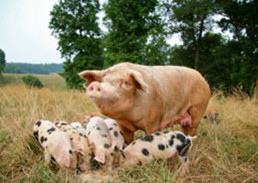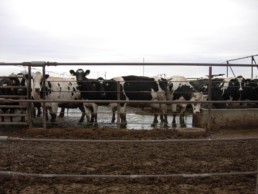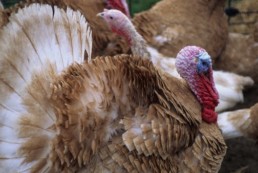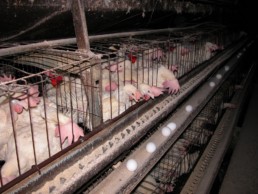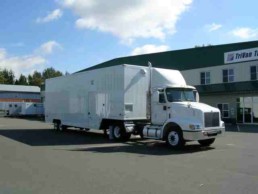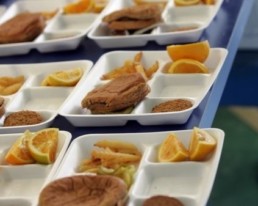Honoring The Food Animals On Your Plate
From the cream in our Monday morning coffee to the roast chicken at Sunday night dinner, we accrue an incalculable debt to food animals. We depend on them for nourishment. We gather festively around the cooking of a turkey or ham during holidays. Yet many people do not realize that most of the animals that grace our tables are the victims of harsh suffering long before slaughter.
Consider the modern turkey. It is far removed from the wild, native bird that the pilgrims roasted for those original Thanksgiving gatherings. Today’s conventional turkey, the Broad Breasted White, is an entirely industrial creature. It is bred to grow freakishly quickly and raised on grain inside massive buildings. Most male turkeys, or Toms, become so breast heavy, they can barely stand up – and certainly can’t reproduce. Artificial insemination is the only way this man-made species survives.
Such mass-production meat factories – called “concentrated animal feeding operations,” or CAFOs – exist for most of the animal food products Americans buy: cows, pigs and chickens. At least 90 percent of food animals in the U.S. are raised this way, and other countries are rapidly adopting the CAFO model as well. These enterprises are a perverse inversion of our idea of family farms with pigs rolling in the mud, cows grazing in pastures, roosters crowing from fence posts, and farmers interacting with the animals. At CAFOs, vast numbers of animals—100,000 cows on a feedlot, 30,000 chickens in a broiler shed, 1,000 hogs in a windowless warehouse—are confined in pens or cages, often kept alive with regular doses of antibiotics.
As CAFOs take over the food system, it is clear that there is already plenty of animal protein in our diets. Americans now eat an average of 33 pounds of cheese each year, for example, largely because of the flood of cheap milk coming from dairy CAFOs. This is three times the per capita consumption of the 1970s. Cheese is the largest source of saturated fats in our diets, which tend to raise cholesterol levels and are linked to heart disease. Dairy products, meat, poultry, and eggs don’t have to be nearly so cheap or abundant – and yet we are raising 10 billion food animals in the United States every year.
The high costs of factory-farmed foods are being paid for by the animals, rural communities, taxpayers, and the environment. Large-scale animal operations generate the sewage output comparable to a small metropolis.The waste oozing from these highly concentrated production systems fouls the air, land, and water. Sadly, if you purchase animal products from fast food restaurants, supermarkets, big box stores, or other mainstream outlets, there is a strong chance that you are eating at the expense of someone else’s community well-being.
You don’t have to become a vegan or vegetarian to opt out of this system that might best be described as “organized irresponsibility.” (Those are certainly viable options, however.) Some of the country’s best small farmers are demonstrating that traditional methods of livestock production are practical and economically viable. They are raising locally adapted breeds of livestock on pastures where the animals eat a more natural diet, grow more slowly, and naturally socialize. These animals are also raised without routine doses of antibiotics and growth hormones, essential tools in industrial CAFO production. Third-party certification organizations such as Animal Welfare Approved have established standards combined with regular audits to encourage such humane production practices.
Still, labels can be confusing, and some like “natural” and “healthy” are misleading. The best way to know where your food comes from and how it was produced is to know your farmer.
The other way to reduce the role of CAFOs is to scale back the amount of meat we consume. Many individuals are simply orienting their meals around more grains and vegetables with smaller portions of higher quality, sustainably sourced meats, dairy, and eggs. Another groundswell is the Meatless Monday campaign, which has already been embraced by chefs, restaurants, food services, k-12 schools, and college campuses.
Attending to the conditions under which your food is raised is a profound way of giving thanks to the animals that nourish you daily. It can also lead to some of the most satisfying meals you’ve ever shared or tasted.
Resources:
CAFO: The Tragedy of Industrial Animal Factories
Grass Pastured Meats
This piece was originally published on Huffington Post.
Confessions of a Reluctant Wonk
First, a confession. I am a reluctant wonk. Despite writing rather extensively about food and agriculture policy, acronyms are not what motivate me in the morning. After about a half an hour of studying something as dense as the Farm Bill, I need a diversion, a few minutes of deep breathing outside with my feet on the ground, or some quality time with Fanny, my Australian shepherd.
I do believe that agriculture is indeed a public good. Food and farm policy are not a necessary evil but a real privilege and opportunity for a country and its people. It is wise to invest in conservation, clean water, soil protection, and habitat enhancement for our collective good. The natural world, well attended, cannot keep pace with the growth demands of the industrial economy and Wall Street. Unfortunately, our rural lands, farm animals, and agriculture workers are being driven by efficiency, industrial concentration, and profit taking. Rather than investing in tangible returns and long-term security, agriculture policy is pushing us toward the brink of collapse on many fronts.
For those who care about healthy food, the Farm Bill is something we all need to digest—even in small helpings. The information is out there, accessible and more organized than ever before, even if the situation is not so rosy. (Check out www.farmpolicy.com everyday for a week to get started.)
The Farm Bill is a massive legislation that is revisited every five to seven years. The next renewal is scheduled for 2012 but it could likely drag on into 2013 or beyond. For the last few decades the Farm Bill has been dominated by two primary political forces: a nutrition and hunger bloc that fights for food stamps (now known as SNAP) and other assistance; and the commodity agriculture lobby (corn, cotton, wheat, rice, soybeans, dairy, sugar producers, and concentrated animal feeding operations or CAFOs). This is your basic quid pro quo. Urban legislators get food assistance for the 40 million Americans facing hunger on a regular basis. Farm country legislators bring home the bacon to huge agribusinesses that are now raking in record profits.
My least favorite of these commodity players hijacking taxpayer dollars are the CAFOs. Not only are their factory animal farms morally reprehensible, they are fouling the air, water and land in the communities where they have taken over and are feasting at the public trough in the process. Their economic model is based upon a steady supply of Farm Bill subsidized feeds—corn and soybeans—that has saved them billions of dollars over the last decade. (This is well documented in a report by Timothy Wise and Elanor Starmer from Tufts University). In 2002, the CAFO industry began raiding precious Farm Bill conservation dollars to pay for nasty manure lagoons and waste management infrastructure. A single CAFO investor can qualify for $450,000 in Environmental Quality Incentive Program dollars to pay for his or her own pollution compliance. (Read Martha Noble’s essay inThe CAFO Reader for a more detailed summary.)
One would think that once the CAFOs and other commodity producers get their 10 billion to 20 billion dollars each year from the taxpayers, their lobbyists would be content to let the rest of the players fight over the scraps: a few billion here for conservation, a few million here for rebuilding local food capacity, a few million for those organic farmers who pay high certification costs just to prove they are doing the right thing. But agribusiness is not content. They are fighting for every last cent of Farm Bill dollars and doing all they can to paint the burgeoning good food movement as fringe and meaningless.
Last year, Senators Mc Cain (R-AZ), Chambliss (R-GA) and Roberts (R-KS) publicly attacked Secretary of Agriculture Tom Vilsack and a small program named Know Your Farmer, Know Your Food. KYF 2 (in Wonk speak) was spending approximately $65 million to rebuild local food systems around the country, including developing new markets in urban areas for rural farmers hoping to expand their businesses. In highly divisive language, the Senators claimed that this money was benefitting organic hobby farmers supplying urban elites at farmers markets, rather than “Production Agriculture.” This is the term for heavily subsidized monoculture commodity farmers that largely grow crops we don’t directly eat. Just to give some perspective on that $65 million Know Your Farmer program budget, Brazilian cotton farmers received $165 million last year from our government in retaliation for past U.S. cotton subsidies deemed illegal by the World Trade Organization. The Senators wrote no nasty letters to the Secretary about those payouts to farmers in another country as far as I know. Then again, there are a lot of cotton farmers in Arizona and Georgia.
Last week the rules were finalized on another 2008 Farm Bill program called the Farm and Ranchland Protection Program (FRPP). One would hope this money would go to protect beautiful farmlands in areas threatened by sprawl and development. But in keeping with their strategy of fighting for every last cent of the Farm Bill pie, agribusiness lobbyists were able to make a CAFO manure lagoon (a cesspool of waste) eligible for protection under Farm and Ranchland Protection Program easements. Maybe there is something I don’t quite understand — such as even small operations have such holding facilities — but somehow this doesn’t seem what the program was intended to preserve. (Read the National Sustainable Agriculture Coalition’s report here.)
As you can see, foodies, foodists, healthy food activists, and concerned citizens have no choice but to begin to understand the detailed maze of farm policy. Our challenge is to move from acting individually to developing collective clout. It’s the only way voting with our forks might begin to change the enormous power corporate agribusiness wields over our food system.
Down on the Factory Farm: The Lower Yakima Valley
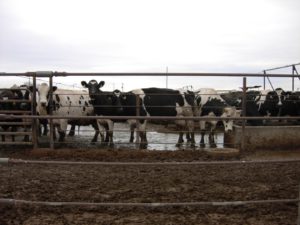
 With a slate gray sky threatening rain on an early November day, I drive up to the Lower Yakima Valley to meet anti-factory farm activist Helen Reddout. She is the founder of Community Association for Restoration of the Environment (CARE), a group that has battled industrial dairies in southeastern Washington State for over 15 years.
With a slate gray sky threatening rain on an early November day, I drive up to the Lower Yakima Valley to meet anti-factory farm activist Helen Reddout. She is the founder of Community Association for Restoration of the Environment (CARE), a group that has battled industrial dairies in southeastern Washington State for over 15 years.
An older woman of smallish stature, Reddout doesn’t look like your typical public defender (if there even is such a thing). She is in fact a farmer and still runs the cherry business she started with her husband many decades ago.
But it only takes 5 minutes for me to realize that Reddout has done a lot of homework and is not afraid of confrontation. In the mid-1990s, she explains, as we pile in the car to start our tour, an influx of mega-scale dairies, primarily from southern California, tragically transformed a valley with a diversity of small family farms into a toxic nightmare. At first she thought the agencies would deal with the perpetrators and the sewage that immediately began to overwhelm her rural community. One day she realized that they weren’t going to take action and began to fight back.
The remnants of that former patchwork of diversified agriculture are still visible in the Lower Yakima. Feathery fields of asparagus now golden and red, the heavy bushes tilting towards winter dormancy. Orchard blocks of cherry, apple and pear trees. Stubble and angled stalks from fields of feed corn now harvested. Increasingly what we see dominating the farm economy here, however, are huge operations with very large concentrations of black and white Holstein dairy cows.
The cows are not out grazing in the green rolling pastures. Some operations have shiny aluminum siding, cement floors, and stall systems that stretch on for hundreds of yards like municipal airport hangers. At others, the cows are confined in open corrals on vast manure and muck lots, spending the day walking and standing in their own waste. Adjacent to all these pens and enclosures are manure cesspools of all kinds. There are concrete holding tanks, unlined lakes brimming with sewage, massive pits carved into the earth waiting to be filled. There are more than 200,000 cows on the 70-plus CAFOs in a 19-mile corridor in the area, estimates Reddout. But she encourages me to call around to the local agencies, because she says even they don’t know how many cows are actually in the valley anymore.
At approximately 125 pounds of waste per cow per day, you begin to get the brutal picture of what it’s like to have your community taken over by industrial dairies. It seems as if you combined all the liquid waste from the dairies we drive by, it could easily fill a stadium. Manure is being sprayed on surrounding fields through large central pivot irrigation booms and smaller manure cannons, pumped from one holding area to another. As the storm touches down, the shit smeared fields begin to glisten in the rain. The waste enters my senses through a variety of pathways: burning nose, throbbing temples, nauseous stomach. One can easily imagine manure ponds overflowing, fields saturated, and waste literally running into ditches and along roadsides. No wonder property values have plummeted and real estate sales have stalled out. Many residents couldn’t move even if they want to.
The entire system seems to be predicated on organized negligence. There is clearly both too much waste and too much milk. Reddout tells us that with the national glut of milk, much of the output here will be exported or dehydrated or made into cheese. Meanwhile the kids in the local schools are at risk of their water supply being contaminated by e.coli or nitrates. Most of the small dairy farmers have been driven out by the big corporate dairies who concentrate more animals on their lots for ever-diminishing returns on bulk milk prices. Starlings and magpies flock around these operations, becoming unwitting transmitters of mold and bacteria around the community. Then there is the issue of replacement calves. In order to continue lactating, milk cows must be impregnated every year. Half of the calves will be male and have little economic value. At the end of our tour we pass a hovel of plywood containment huts where male calves are tethered for veal production. Through small cutouts in the wood, you can see the eyes of a few animals staring out.
In 2002, CARE was awarded a $1 million decision against a local dairy operator for violations of the Clean Water Act. Half the money went to the Western Environmental Law Center in Eugene, Oregon, the legal defenders who took on the case; the remainder went to an organization that conducted an extensive study of well and groundwater quality throughout the entire valley. Meanwhile the fight goes on and the industry searches for ways to expand the number of cows in the valley.
The latest scam involves raising millions of dollars in public funds to install industrial digesters on top of the waste pits that capture methane gas for energy conversion. It’s a concept sold to the public as a green energy solution, even if the millions of taxpayer dollars invested may never be recouped, and nitrates may still pollute the environment, and the industrialization of the dairy cow will continue.
Before I head back to the safety of my own community, I ask Helen Reddout what she wants. Without hesitation, she tells me she wants the dairy CAFOs to leave her community for good and for family farming to return to the Lower Yakima. The routine use of antibiotics whether animals need them or not, she argues, should be stopped, as it leads to the proliferation of antibiotic-resistant pathogens that threaten human and animal health. She wants the federal subsidies that provide cheap grain to CAFO operators and other taxpayer supports eliminated. And she wants to see any remaining dairies to follow the lead of her neighbor Allen Vourtman, who grazes 350 cows on pastures next to her home, and takes the welfare of his cows, and their impacts on the health of the local environment very seriously.
From what I've seen, Helen Reddout doesn’t seem to be asking too much.
For a great article on the dairy industry and the USDA from Pulitzer Prize winner Michael Moss, read this piecein the Nov. 6, 2010, New York Times.
The Totally Outsourced Life
It used to be that we made things in this country: you know, stuff, all kinds of things from heavy machinery to automobiles, clothing, furniture and electronics. My family ran a small woodworking and printing business in a mixed industrial and agricultural county in south central Pennsylvania. That factory was eventually shuttered, but for most of my formidable years we employed over 100 skilled workers, many who ran small farms in their off time and during the weekends. Gradually we Americans learned to “outsource,” a fancy term meaning that the owners of businesses and corporations maximize profits by moving operations wherever labor is cheapest and environmental laws are nearly nonexistent. This left us with the job of financing, designing, distributing, marketing, and importing the now outsourced goods — sending much of the money that used to remain in our own communities offshore.
The unmaking of the America that used to make things was a gradual wearing away. Early industrialization centered in the northeast. Then it crept slowly across the south, like a great blight, leaving a rust belt in its wake. (Before we outsourced overseas, we had a lot of practice outsourcing in our own country.) It is almost impossible for me to return to my childhood home anymore without feelings of deep despair. Economic development has all but stagnated. The woods and farms have long been carved up for golf courses and mutant housing developments (many unoccupied) that serve as a tax haven for commuters to Baltimore (an hour drive to the south). Nearly all manufacturing eventually moved offshore: first to Japan then Taiwan, Hong Kong, South Korea, Indonesia, India, China, Viet Nam, moving like a domino effect to wherever people are willing to work for less than the last outsourcing mecca. What wasn’t outsourced to Asia ended up in Central America, especially to the maquiladoras along the U.S.-Mexico border once NAFTA passed.
The American financial system found a new way to grow the economy: credit. If everyone lived on credit, we could keep buying all the stuff that had been outsourced and was now piling high in malls and box stores, which had in turn outsourced most of the traditional local retailers as well. Once the credit ran out in America, the countries that were making the goods began extending the credit. We know all too well the outcome of that story when the bills finally came due. The banks were too big to fail. But millions of people lost their homes and without any manufacturing sector to speak of, or money to pay for stuff, the economy ground to a halt.
Global swings of money and economic power are not new to history or the international economy. In the nineteenth century, when a country’s worth and economy were actually based upon real assets like how much gold bullion and silver were in the government coffers, western trading nations became more than a bit rattled when vast stores of their wealth were being shipped off to Asia to meet rising demand for things like pepper, tea, silk, and other goods. The English retaliated by smuggling opium into China. This was done against the direct wishes of the emperor who cautioned his people against what a narcotic addiction would do to their cultural fabric. But like, credit and cheap disposable things that make life convenient, opium is a powerful addiction.
In a shameful effort to regain their vanishing wealth, the English bought opium from India and transported it into China only in return for gold. This way they cracked the nearly impenetrable fortress of the Imperial Chinese economy. Ultimately, it signaled the beginning of modernization, decade after decade of internal wars and revolution, and the end of dynasty rule in China.
Today, we Americans are faced with our own self-imposed addiction — we are strung out on the consumption of disposable products that fuel our convenience-driven lifestyles. Imagine that one of the biggest export items from California, among the world's ten most powerful economies, is recycled cardboard, from the boxes used to import all the cheap outsourced products. We are credit junkies, living by turning our houses and mortgages into ATM machines, and doing all in our powers to keep the faucet of cheap outsourced products flowing. Unlike imperial China, our economic leaders do not caution us to be more disciplined. Instead we are asked to grow the economy once more by consuming — keeping that addiction satisfied — rather than building an infrastructure to make things for ourselves. Consumption detached from production is an opiate, something that may satiate us from purchase to purchase, but keeps us from dealing with the real enemy at the gate. The totally outsourced life, in which purpose and the making of basic necessities has tragically gone missing.
Giving Thanks: Honoring Your Food Animals Over the Holidays
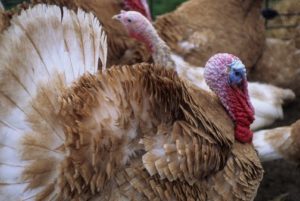 The end of year holidays are times when families gather around their tables, sharing meals and company, often organized around the cooking of a turkey, ham, or roast. During the three-month feasting period between Thanksgiving and the Super Bowl, we whip cream to dollop on pumpkin pies, sip egg nog, share breakfasts of eggs, bacon, sausage, cream cheese and lox. What many people may not realize, is that the many animals that we depend on for holiday meals and snacking, can be the victims of harsh suffering and tremendous environmental degradation. It doesn’t have to be this way.
The end of year holidays are times when families gather around their tables, sharing meals and company, often organized around the cooking of a turkey, ham, or roast. During the three-month feasting period between Thanksgiving and the Super Bowl, we whip cream to dollop on pumpkin pies, sip egg nog, share breakfasts of eggs, bacon, sausage, cream cheese and lox. What many people may not realize, is that the many animals that we depend on for holiday meals and snacking, can be the victims of harsh suffering and tremendous environmental degradation. It doesn’t have to be this way.
Consider the Thanksgiving turkey. The bird that the pilgrims sat down to enjoy on those original Thanksgiving gatherings was wild and native to the continent. Today’s conventional turkey is an industrial creature, the Broad Breasted White, bred to grow at a freakishly fast pace, raised on grain inside massive barns where their quality of life is severely compromised. In fact, male turkeys, or Toms, now grow so big so fast and are so breast heavy, most can barely stand up. Natural reproduction is out of the question. The industrial turkey is a totally manmade construction, dependent on artificial insemination. Often times to add flavor to these industrial birds, the meat is injected with vegetable oils, saline solutions, or animal proteins.
A similar factory-like scenario applies to most of the animal food products Americans buy around the holidays: cows, pigs, and chickens. An increasing majority of animals in the U.S. and other countries are raised in factory farms or CAFOs (concentrated animal feeding operations.) These enterprises are not the family farms of past times, with pigs rolling in the mud, cows grazing in pastures, and roosters crowing from fence posts. CAFOs are industrial-scale facilities where vast numbers of animals are confined, kept on life support with antibiotic medicines, and generate an output of sewage or waste comparable to a small metropolis.
The good news is that alternatives to this tragic animal factory scenario are out there and you don’t have to be a vegetarian to participate. (Though that certainly is an option.) Farmers around the country are increasingly turning toward better methods of livestock production. They are raising rare heritage breeds of turkeys on pastures where the birds grow more slowly and eat a more natural diet and are part of a local food economy. Many producers now raise animals without antibiotics and growth hormones, essential tools in industrial CAFO production. A number of organizations have standards for organic production and animal welfare. Many cooks are featuring a lot more grains and vegetables with perhaps smaller portions of higher quality, sustainably sourced meats, dairy, and eggs.
Knowing your farmer and understanding the conditions under which your food was grown is a profound way of giving thanks that also includes the raising of the animals that do so much to enrich our holiday celebrations. It could also lead to some of the most satisfying meals you’ve ever shared.
A few resources:
Egg Recall Reveals Scrambled Priorities
Contamination is just part of what's wrong at massive animal factories
The recall of a half billion eggs from two Iowa agribusinesses, Wright County Egg and Hillandale Farms, because of salmonella contamination is still dominating the news. Earlier last month the news was the withdrawal of a million pounds of E. coli tainted hamburger. That was followed by nearly 400,000 pounds of deli meats infected with listeria. Who knows exactly where the next outbreak will pop up, but it seems certain to come again from the world of industrial animal food products.
Americans have a seemingly insatiable appetite for meat, poultry, dairy and eggs, even as food safety issues increasingly become headline news. What many people are coming to realize, however, is that the majority of these farm animals are no longer raised on the pastures and barnyards of family farms but inside CAFOs: concentrated animal feeding operations. The farming of animals in these crowded, often filthy, factory-like facilities raises a host of health, environmental and ethical concerns. Salmonella is just the tip of the iceberg.
The concept behind the CAFOs is simple: Cram as many animals into the smallest possible space for maximum growth at the least expense. Laying hens and hogs seem to suffer the harshest fate under this system. A conventional laying hen lives out her days in a wire confinement pen called a battery cage. Confined in the cage with a number of other cell mates, she is normally allotted an area little smaller than a cubic foot to live out her short productive life, never experiencing the outdoors, scratching the dirt, naturally socializing or enjoying any privacy to nest. As soon as her productivity declines in a year or two, she is removed from the cage and slaughtered for processing (for pot pies or soups), asphyxiated (because her meat is not worth the expense of processing) or sometimes buried alive and composted. Charles Dickens would have a hard time conjuring a grimmer scenario.
The CAFO industry, some farmers and even the U.S. Department of Agriculture insist that factory-farm systems that house thousands of battery cages in a single building are necessary and even better for the birds and for food safety. It's certainly true that all food production systems -- small, medium, and large; organic, pasture-based and industrial; local, national and international -- are prone to risks of contamination. But with tens or hundreds of thousands of animals in close confinement, when something goes wrong inside a CAFO, it can spread far and fast. Contamination can quickly sweep through the integrated production networks of feed and hatcheries, through an animal population and out into the food system. Iowa is a perfect example: Those half a billion recalled eggs came from just two so-called "farms" with 7.5 million hens between them.
Industry is quick to counter-attack that shifting to cage-free, pasture-raised or organic egg laying operations will mean higher check-out prices. Economic conditions being what they are, any talk of rising food prices creates anxiety. Yet that hasn't stopped large numbers of U.S. consumers from flocking to small producers to buy eggs -- even at a premium -- in the wake of this recall.
Fortunately, millions of people are waking up to the consequences of a food system dominated by massive corporations: the loss of regional food production capabilities in the face of impending fuel shortages; tax-funded subsidies that prop up feed grains; antibiotics given to animals that pass into the broader environment; obscene volumes of waste in concentrated areas; a legacy of abysmal treatment to the animals we depend upon for sustenance. For the sake of our health, our environment and our economy, should we let this continue?
Change is in the air. Most countries in Europe and a number of U.S. states have taken measures to ban the most restrictive technologies used in CAFOs, such as the battery cages.
But we need not wait on federal or state regulations. We have a say in the kind of world we want, and it is expressed in the food choices we make every day. It's in our power to participate in a healthier food system, one egg at a time, one farmers market at a time, one meal at a time. It starts with simply understanding and honoring where our food comes from. At that point, the foods produced in CAFOs become a lot less appetizing and ultimately, unpalatable.
This article previously appeared in the Zester Daily.
Further Reading on WorldPoultry.net, a poultry industry publication.
"Know Your Farmer" Program targets small-scale, rural meat producers for assistance
This Blog post was written by Emmett Hopkins, a Northern California vegetable farmer (Foggy River Farm) and Watershed Media research assistant.
Critics have accused the USDA's new "Know Your Farmer, Know Your Food" program of siphoning money from rural farming areas to prop up "urban locavore markets." As a farmer, I feel the opposite is true. The program is specifically looking for ways to create more agricultural opportunities in rural areas by removing barriers to small-scale farming.
As described in a previous Watershed Media blog post, a trio of Republican senators, including John McCain, recently wrote a letter to Secretary of Agriculture Tom Vilsack complaining that the program is "aimed at small, hobbyist and organic producers whose customers generally consist of affluent patrons at urban farmers markets.” The subtext of this statement is this: the "Know Your Farmer" program is supporting small-scale meat and vegetable farmers who sell directly to consumers instead of big agribusiness farmers that grow commodity crops like corn, soy, and factory-farmed animal products. And in this the senators are right; "Know Your Farmer" is trying to make it easier for small-scale, rural farmers to survive.
Small-scale Meat Producers & Mobile Slaughter Units
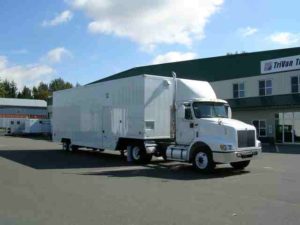 Funded under "Know Your Farmer," the USDA has recently rolled out a series of tools to promote small-scale meat processing in rural areas. At a time when the vast majority of the meat industry is controlled by three or four multinational corporations, local processing facilities are sorely needed. In many regions, animals farmers would currently have to trek their livestock across state borders to find the nearest state or federally approved processing facility. A study funded through "Know Your Farmer" shows all the geographic gaps between the country's meat producers and the facilities that can legally process their chickens, steers, and hogs. The study's charts show hundreds of counties with no nearby options.
Funded under "Know Your Farmer," the USDA has recently rolled out a series of tools to promote small-scale meat processing in rural areas. At a time when the vast majority of the meat industry is controlled by three or four multinational corporations, local processing facilities are sorely needed. In many regions, animals farmers would currently have to trek their livestock across state borders to find the nearest state or federally approved processing facility. A study funded through "Know Your Farmer" shows all the geographic gaps between the country's meat producers and the facilities that can legally process their chickens, steers, and hogs. The study's charts show hundreds of counties with no nearby options.
To help close these gaps, the USDA is promoting mobile slaughter units--essentially butchers on wheels, able to travel from farm to farm to process meat where it wouldn't otherwise be possible. There are currently only nine such roaming facilities in operation in the U.S. (4 in Washington State and one in Alaska, California, New Mexico, New York and Texas). A group of farmers in San Juan County, Washington organized the first of these mobile less than ten years ago. The 36 foot truck and trailer unit began accepting animals for processing in 2002. It can process 10 beef, 24 hogs, or 40 sheep per day with two butchers.
According to Neil Gaffney, press officer for the Food Safety and Inspection Service, "mobile processing facilities are viewed by the USDA as one mechanism that helps support the goals and objectives of 'Know Your Farmer, Know Your Food.'" To help spur more development of mobile slaughter units, the USDA has taken the following steps (as detailed by Gaffney):
- FSIS launched a toll free help desk last December for small meat and poultry processors, which will support USDA's "Know Your Farmer, Know Your Food" initiative by helping small processors to reduce the time and expense of dealing with agency requirements.
- FSIS held outreach webinars this past January on mobile slaughter units, and produced a video to help prospective producers with the requirements on setting up a mobile slaughter facility.
- In May, as part of the Know Your Farmer, Know Your Food initiative, the Agency announced the availability of the FSIS compliance guide for mobile slaughter units (available at www.fsis.usda.gov/Significant_Guidance/index.asp), a document that can help small processors and establishments who own or manage mobile slaughter units meet food safety regulatory requirements.The document is not a regulatory requirement.
- FSIS also released a preliminary study as part of that initiative in May revealing existing gaps in the regional food systems regarding the availability of slaughter facilities to small meat and poultry producers. The data in the study creates a county-by-county view of the United States, indicating the concentration of small farms raising cattle, hogs and pigs, and chicken, and also noting the location of nearby state slaughter facilities and small and very small federal slaughter establishments. (See "Slaughter Availability to Small Livestock and Poultry Producers – Maps" at:http://www.fsis.usda.gov/PDF/KYF_maps-050410_FOR_RELEASE.pdf.)
- On June 24th, the Agency hosted a red meat mobile slaughter unit information session at the Washington County Agricultural Center in Boonsboro, Maryland, to educate farmers, ranchers and processors on how to set up mobile slaughter units, receive the federal grant of inspection and meet USDA food safety requirements.
The hope is that, over time, these efforts will help build the infrastructure needed to support small-scale, regional meat producers.
But why is it important to help small-scale farmers in the first place?
In today's agricultural arena, small-scale, family farms are routinely being squeezed out by corporate operations. In several years' time, we may be hard pressed to find more than a hand full of small, independent growers. According to a recent Worldwatch report, only four companies control 60 percent of terminal grain facilities. Cargill, Archer Daniels Midland, and Zen Noh control 81 percent of U.S. corn exports and 65 percent of soybean exports. And three companies--JBS, Cargill, and Tyson together dictate over 75 percent of the U.S. beef market and four companies more than 65 percent of the U.S. pork market. Chicken and turkey are not far behind. In almost every agricultural sector--from meat production and processing to fresh fruits and vegetable farming--the little guy is becoming an endangered species.
The USDA is wise to identify this trend as a potential long-term problem and take steps to stop the bleeding. Agricultural consolidation poses major risks to both our food safety (outbreaks are hard to track in the factory-farming model) and our food security (if we delegate all our agricultural resources to a few companies, we're more likely to lose them.) Corporate consolidation also threatens to dismantle the rural communities that have formed the bedrock of the nation for centuries. As agriculture becomes more and more large-scale and mechanized, farmers find themselves out of work and farming communities have to shutter their doors. To combat this, Neil Gaffney says, "the initiative is working to break down barriers that keep local food systems from thriving, and create new opportunities for farmers, ranchers, consumers and America’s rural communities."
For information about all the mobile slaughter units around the country:http://www.extension.or/page/Mobile_slaughter%2Fprocessing_units_currently_in_operation
For photos and video of mobile slaughter units:
http://www.mobileslaughter.com/photos.htm
Slow Food USA article on Mobile Slaughter Facilities and Food Safety:
http://www.slowfoodusa.org/index.php/slow_food/blog_post/mobile_slaughter_facilities/
Deputy Secretary of USDA, Kathleen Merrigan, on Mobile Slaughter Units:
http://brownfieldagnews.com/2010/01/25/merrigan-says-mobile-slaughter-units-have-a-role/
The Myth of Containment
The blog post was written by Watershed Media board member Diana Donlon.
In the mid-1980s when I was studying history in college, “containment” - as in stopping the spread of communism - was a ubiquitous topic. The threat of communism has long-since waned, but the theme of containment has resurfaced albeit in a different, but tragically visceral guise. The ongoing calamity in the Gulf is quite literally a failure of containment. BP gambled with a risky technology. The government was sloppy in its due diligence. And both otherwise powerful entities have proved to be virtually powerless to stop the hell they’ve unleashed. Late last month Bob Herbert of the New York Times likened “the oil gushing furiously from the bowels of earth” to “a warning from Hades.”
There are instructive parallels between the uncontained oil catastrophe and genetically engineered technology. Like the oil companies, the bio-technology companies pushing genetic engineering (GE) are gambling with the fundamental integrity of our ecosystems. Bio-tech gambling, however, is taking place at the molecular level largely out of public view and mostly without our knowledge or consent.
On April 27, 2010 the Supreme Court heard its first ever case addressing genetic engineering -- Monsanto v. Geertson Seed Farms. Monsanto was appealing a Federal court decision that USDA failed to abide by environmental protection laws when it approved “Roundup Ready Alfalfa” for commercial sale. Roundup Ready Alfalfa (RRA) has been genetically altered to be resistant to glyphosate the active ingredient in Monsanto’s flagship Roundup herbicide. The justices’decision on the case was announced on Monday (June 21). In a 7- to-1 decision, with Justice John Paul Stevens dissenting, the Supreme Court ruled that the lower court judge had gone too far in imposing a national ban on RRA. Both sides immediately started claiming victory. But, before we consider the implications of the high court’s decision, let’s back up a moment and ask why we should care about a seemingly obscure legal case in the first place?
Hay is the third largest crop grown in the United States. And, in this country the primary hay crop is alfalfa. Most alfalfa is fed to dairy cows. Dairy cows produce dairy products including milk.
In 2007 the Federal court held that the USDA had failed to abide by environmental protection laws when it approved RRA for commercial sale. Citing its potential to contaminate organic and conventional crops, the court halted any further planting and sale of Monsanto’s RRA. The Federal court granted an injunction banning all plantings of the GE alfalfa until USDA fully complied with environmental laws and rigorously assessed the crops’ impacts. Monsanto already controls corn and soy, the two largest crops, and would like to add alfalfa to its impressive roster. Unsatisfied with Federal court ruling the company took the case to the Supreme Court.
During the oral argument on April 27, Justice Scalia stated that, “This isn’t the contamination of the New York City water supply. It really isn’t.” With all due respect to Justice Scalia, it isn’t, but he was close. It could be the potential, irreversible, genetic contamination of the food supply.
Some question how a Roundup Ready Alfalfa plant could contaminate a conventional or an organic plant. The answer is pollination. Alfalfa is an open-pollinated crop. Bees, wind, and other pollinators can carry pollen at a distance of several miles from the genetically engineered Roundup Ready plants and cross-pollinate the non-Roundup Ready Alfalfa plants. Pollination has the potential to wreak havoc by spreading patented, foreign DNA that is proprietary to Monsanto. And, like BP and its infamous Deepwater Horizon well, the Monsanto Corporation and the government will be utterly powerless to contain the damage it unleashes on the commons.
In Greek mythology Zeus was angry with Man because, with the help of Prometheus, Man had stolen fire from the gods. Zeus planned his revenge on the mortals by giving Pandora a box or a jar. He told her that the box contained ‘special gifts’ but that she must never, under any circumstances, open it. One day Pandora’s curiosity got the best of her and she lifted the lid slightly. Out flew disease, despair, hunger, poverty, war, sickness, death, old age, greed and violence. Frightened by what she saw, Pandora tried desperately to close the vessel but, her efforts were in vain and only hope remained. Like a big, bad oil slick, the evils oozed all over the earth and have plagued us ever since.
At first glance it looks like Monsanto has won, but the decision isn’t so black and white. The Supreme Court did not make a decision on the safety of RRA and left the lower court ban in place. In sum, the ban on planting Roundup Ready Alfalfa still stands. The lid is still on the jar. If we have learned to stop gambling with too-big-to-fail technologies that once unleashed cannot be contained, we will keep it firmly in place.
Diana Donlon is a philanthropic consultant to foundations in the Bay Area. Her area of specialty is the food system.
Republican Senators Take Aim at Small Farmers, Urban Consumers, and Locavores
In late April, a trio of Republican senators––John McCain (AZ), Saxby Chambliss (GA), and Pat Roberts (KS)––wrote an angry letter to Secretary of Agriculture Tom Vilsack, debunking a recent USDA program called “Know Your Farmer, Know Your Food.” This initiative distributes grant money and loans with the goal of strengthening local food chains and linking consumers with farmers.
The Senators accuse USDA Deputy Secretary Kathleen Merrigan of diverting urgently needed funds from rural communities in favor of: 1) “specialty crops” (the government’s term for fruits, nuts, and vegetables, of which the USDA recommends each of us eat at least five servings a day); and 2) small growers and organic farmers (who the Senators stereotype as hobby producers “whose customers generally consist of affluent patrons at urban farmers markets.”)
They conclude that
“American families and rural farmers are hurting in today’s economy, and it’s unclear to us how propping up the urban locavore markets addresses their needs. Given our nation’s crippling budgetary crisis, we also believe the federal government cannot afford to spend precious rural development funds on feel-good measures which are completely detached from the realities of production agriculture.”
The not so subtle subtext of this letter is that to be a “real” farmer, you must be engaged in “production agriculture.” One can only assume this means corn, cotton, wheat, rice, and soybean production—the five primary commodity crops grown across hundreds of millions of acres in factory fields, propped up by the lion’s share of $15-plus billion in yearly USDA farm bill payments. In their view, the small producers benefitting from the Know Your Farmer program are not just do-gooders raising organic heirlooms for elite urbanites. They’re sucking away subsidies that should be going to the nation’s real farmers. Never mind that there are now more than 5,000 farmers markets across the country; or that an average of 10 million Americans shop at one on any given Saturday during the harvest season; or that farming organically is extremely hard and valuable work.
Here’s the bottom line. The Know Your Farmer program has spent a reported $65 million total so far with plans to invest another up to another $1 billion in loans from the stimulus program. This is peanuts compared with the $60-plus billion in USDA commodity subsidies that production growers presently receive over a five-year period.
Since Senator Chambliss is the ranking minority member of the Agriculture Committee, he and his fellow scribes must be aware that the U.S. is now considering paying Brazilian cotton growers $147.3 million this year because of former production agriculture subsidies that were in violation of World Trade Organization rules. You read that right––Brazilian farmers. The Wall Street Journal recently decried this as madness.
Such divisive political framing sets clear distinctions for how we talk about farmers, food, and our agriculture and nutrition policy. It might also backfire by fueling the fires of public opinion that have been rallying around healthy food production and raging against USDA subsidy programs. It is obvious to an increasing number of citizens and legislators that these programs:
1) divert billions of dollars to commodity agribusinesses whether they have actually suffered losses or not, whether they grow crops or not, with few funding caps, and few social or environmental mandates that would provide a public benefit to taxpayers in return;
2) support industrial crops that are more suited for animal feed, processed foods, and biofuels rather than a healthy, diverse diet;
3) flood the market with cheap, processed ingredients that contribute to a growing crisis of obesity and other diet-related epidemics.
Are these the feel-good measures McCain, Chambliss, and Roberts want us to get excited about?
Instead, they single out a long-overdue and modest attempt to repair links in broken local food chains and educate the public about the importance of knowing your farmer and where your food comes from. Revitalizing local food production can impact the every day lives of citizens––Food Stamp recipients, for example, who can use their Electronic Benefits Transfer cards to buy organic produce at farmers markets; or public school kids that enjoy fruits and vegetables grown by productive farmers in their areas; or small livestock producers that can now process their pasture raised meats with the aid of mobile slaughtering units.
Why don’t the Senators want us to know our farmers or care about where our food comes from? Maybe it’s because they are clinging to the decades-old “Get Big or Get Out” story line that defines how the majority of the country’s food is presently produced. This is the tragic story of 50 years of USDA policies that swept millions of family farmers from the American landscape and gave agribusiness the unimaginable powers they wield today over our entire food system.
Knowing your farmer and knowing your food will become the primary story of the next fifty years of food production. It is the story of saving local agriculture and local farmers before they disappear altogether. In saving regional food production, we become healthier, more engaged, more secure citizens. With quite a bit of leadership, and a comparatively miniscule budget, Vilsack and Merrigan are actually trying to restore relationships and rewrite the stories of decentralized modern farming.
If Senators McCain, Chambliss, and Roberts cared about the health and vitality of rural communities they might be better served to embrace the inevitable rediversification of the food supply. It certainly deserves its fair share—and then some.
Feed Your Children Well
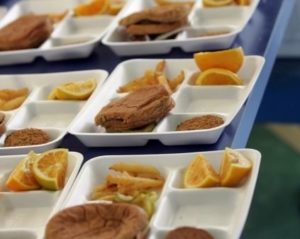 The Child Nutrition Act is up for reauthorization by September 30. This is a federal government policy that sets the rules and standards and uses tax dollars to—among other things—provide a daily reimbursement for school lunches. Right now this amounts to $2.57 for a free lunch, including labor and ingredients. It is nowhere close to what most school districts need to put healthy foods on our cafeteria tables and reward all the people who make that possible. Congress will soon consider adding one dollar per meal to the reimbursement, and this still might not be enough.
The Child Nutrition Act is up for reauthorization by September 30. This is a federal government policy that sets the rules and standards and uses tax dollars to—among other things—provide a daily reimbursement for school lunches. Right now this amounts to $2.57 for a free lunch, including labor and ingredients. It is nowhere close to what most school districts need to put healthy foods on our cafeteria tables and reward all the people who make that possible. Congress will soon consider adding one dollar per meal to the reimbursement, and this still might not be enough.
Often when we think of huge “omnibus” government legislations like the Transportation Bill, the Energy Bill, or the Farm Bill—huge public spending programs with real life consequences—they seem so complex and tedious it is hard to understand how they affect us personally. It’s easy to get lost in the billions and trillions, in the alphabet soup and acronyms, in highway projects and corn monocultures in the Midwest. One of the beauties of the National School Lunch Program is that we can see the impacts on a personal level. We can look around in our communities and see our kids who depend on these programs. The Child Nutrition Act touches home in every community around the country.
This year the US arm of the international movement known as Slow Food is circulating a petition asking for some very reasonable changes to the Child Nutrition Act:
• $1 increase in the reimbursement per meal;
• grants for Farm-to-School and school garden projects to educate every single child in the country on where food comes from, and get the culture back in agriculture;
• financial incentives for schools to purchase as many fruits and vegetables as possible from local farmers to keep that money in the community, and to shorten the distance our food has to travel before it reaches our children’s cafeteria tables.
All this makes sense and deserves our support if only for one single reason. Children need proper nutrition to be good students. They can’t make it through an afternoon of focused attention without healthy food. This is actually a national security concern. We can’t afford to be a nation of under-achievers, at least not if we can help it.
Fortunately, there is a great shift in consciousness occurring around food and public health right now. Locally grown healthy food is being seen as a catalyst and dynamic organizing principle to revitalize local economies, to compensate for a future with less oil, to deal with a planet that is heating up, to address an obesity crisis that is verging on disaster.
The concept of feeding all of our children well, of teaching them about the beauty and complexity of food production through school gardens and local Farm-to-School programs which actually feed them, should be a community as well as a national priority. But in order for these things to happen, Congress needs to authorize more funding for the program. We should see this long overdue increase to the Child Nutrition Act as a down payment on a new generation that will have a lifetime of good eating habits engrained in them. The idea of healthy foods as preventive health care—perhaps even as medicine—is a concept that can and should change the world.
Find Slow Food's petition here.
Find info on HR 1324, a bill introduced by Lynn Woolsey relating to Child Nutrition Act.
Dan Imhoff is the director of Watershed Media, publisher of the newly released book, "Smart By Nature," a collaborative project with theCenter for Ecoliteracy.
